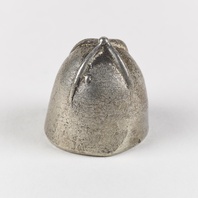
Viking Objects
Reproduction Lead Gaming Pieces
Reproduction lead gaming pieces of a type commonly found across the East Midlands, including at the Torksey Viking camp. The reproductions are tin alloy while the originals were made of lead. These gaming pieces would have been used to play hnefatafl or Nine Men’s Morris, both of which are games known to have been played by Scandinavians throughout the Viking diaspora. It has also been suggested that these might have been weights.
Read More
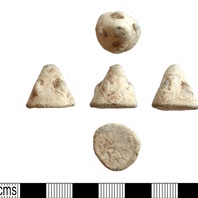
Viking Objects
Lead Gaming Piece (PUBLIC-67DBE3)
This and similar pieces have also been interpreted as weights although the gaming-piece interpretation is more secure. Pieces like this would have been used to play hnefatafl and/or Nine Men’s Morris, both of which are known to have been played in Scandinavia in the Viking Age.
Read More
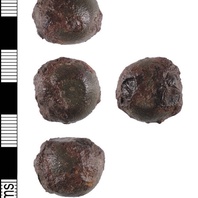
Viking Objects
Globe-Shaped Weight (PUBLIC-D94974)
A globe-shaped copper-alloy weight, with a flat top and bottom each displaying 3 small ring-and-dot motifs. Weights are an important form of evidence for Viking Age commerce and the use of standards across the different economic systems within which Vikings were integrated. Many of the weights discovered, particularly ones in Ireland and those of Arabic type, suggest that a standardized system of weights existed in some areas. These standard weights, alongside standard values of silver, are what allowed the bullion economy of Viking occupied areas to function. A bullion economy was a barter economy that relied on the exchange of set amounts of precious metal in various forms, such as arm-rings or coins, for tradable goods, such as food or textiles. Each merchant would have brought their own set of weights and scales to a transaction to make sure that the trade was conducted fairly.
Read More
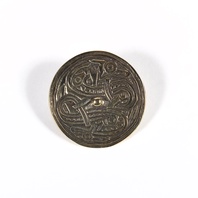
Viking Objects
Reproduction Jellinge-Style Brooch
This brooch contains two S-shaped zoomorphic Jellinge-style designs around a central boss. Brooches like this one were a typical part of female dress. For more information on Scandinavian jewellery in England check out our blog: Brooches, Pendants and Pins: Scandinavian Dress Accessories in England.
Read More
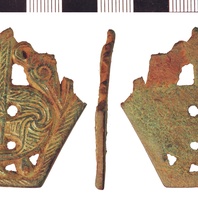
Viking Objects
Copper-Alloy Mount Fragment (NLM-92AFEC)
This copper-alloy mount fragment is likely from a horse harness and is decorated with closely-spaced diagonal hatching framing for a zoomorphic openwork design of four battling beasts around a central roundel. The front of the mount contains extensive traces of gilding. The object is considered an example of Irish or Hiberno-Norse metalwork and thus is associated with Viking activities around the Irish Sea region.
Read More
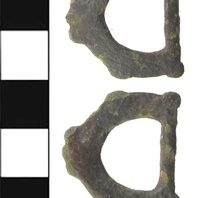
Viking Objects
Ringerike Buckle (SWYOR-22FFC7)
This cast copper-alloy buckle has some elements of the Ringerike style decorating a broad, flat frame and a narrowed strap bar.
Read More
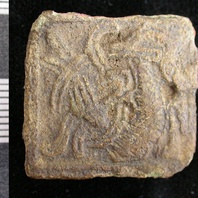
Viking Objects
Square Mammen Style Brooch ( LEIC-6AF276)
This small brooch features a bird depicted in the Mammen style. This style of brooch appears to have been produced in the Danelaw but, generally, Mammen-style decoration is rare in Britain. This brooch from Linwood, Lincolnshire, is paralleled by examples from West Stow Heath, Suffolk, and Bergh Apton, Norfolk, but further examples from Cambridgeshire and East Anglia were found in 2015 and 2016. It is a type which has Carolingian-inspired shapes and Scandinavian decoration. Such brooches were an accessory for women who wore Scandinavian dress. For more information on Scandinavian jewellery in England check out our blog: Brooches, Pendants and Pins: Scandinavian Dress Accessories in England.
Read More

Viking Names
Torksey
Torksey, in the Lawress Wapentake of Lincolnshire, is a difficult name. The second element is Old English eg ‘an island, dry ground in fen, raised land in wet area’, but the first element, though apparently a personal name, is hard to interpret. The most plausible suggestion is that it is the Old English male personal name Turoc. The Anglo-Saxon Chronicle for the year 872 records that Her nam se here winter setle. æt Turces ige ‘And it [the Great Heathen Army] took winter-quarters at Torksey in Lindsey, and then the Mercians made peace with the host’. Recent excavations and other archaeological finds at Torksey are helping to build up our understanding of what that here was and what it did during the winter of 872-3.
Read More
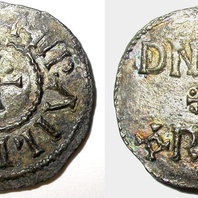
Viking Objects
Viking York Penny (1995-17)
This silver penny was found during demolition work at St Alkmund’s Church in 1967. This type was minted at York for the rulers Sigeferth and Cnut, but this coin has no names, whether of a ruler, a moneyer or a mint. Sigeferth is recorded as being a pirate in Northumbria around 893 and seems to have assumed control after Guthfrith’s death in 895. Cnut is not attested in written sources but Scandinavian tradition places him in Northumbria around the same time. The joint Sigeferth Cnut coins and the sole issues of Cnut were minted around c. 900. This type of penny is known as Mirabilia Fecit from the Latin Cantate Dominum canticum novum, quia mirabilia fecit. Mirabilia fecit means ‘he made it marvellously’ and is the inscription on one side of the coin while the other has the inscription DNS DS REX (‘Dominus Deus rex’ = ‘the lord God almighty is king’).
Read More
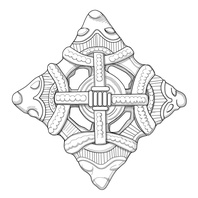
Viking Designs
Drawing of a Lozenge Brooch
Drawing of a copper alloy lozenge brooch in the Borre style. This type of brooch was common throughout the Danelaw in the Viking Age and was used as an accessory by women who wore Scandinavian dress. Scandinavian brooches came in a variety of sizes and shapes which included disc, trefoil, lozenge, equal-armed, and oval shapes. The different brooch types served a variety of functions in Scandinavian female dress with oval brooches typically being used as shoulder clasps for apron-type dresses and the rest being used to secure an outer garment to an inner shift. Anglo-Saxon brooches do not match this diversity of form with large disc brooches being typical of ninth century dress styles with smaller ones becoming more popular in the later ninth and tenth centuries. However, since disc brooches were used by both Anglo-Saxon and Scandinavian women they are distinguished by their morphology. Scandinavian brooches were typically domed with a hollow back while Anglo-Saxon brooches were usually flat. Moreover, Anglo-Saxon brooches were worn singly without accompanying accessories.
